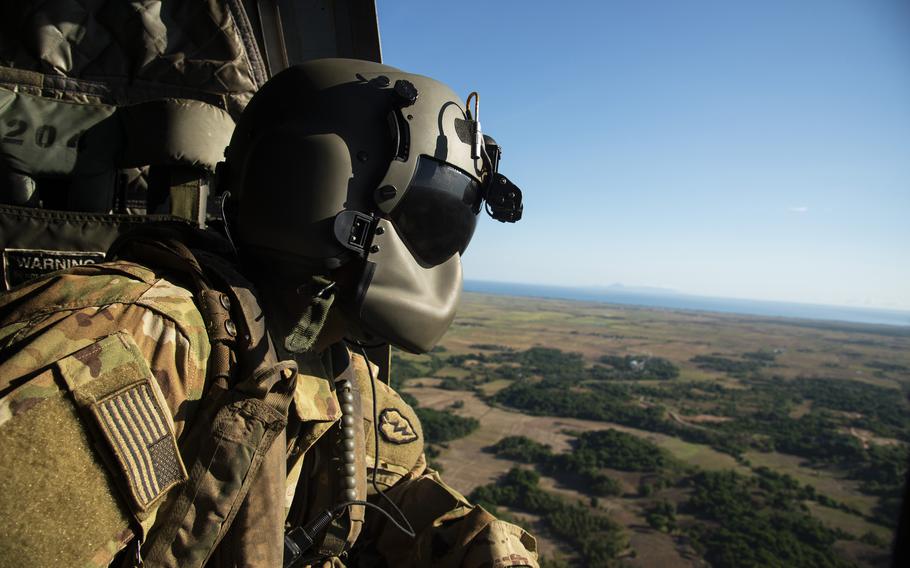
Army Spc. Samuel Sosa, a CH-47F Chinook repairer with 3rd Battalion, 25th Aviation Regiment, flies over Batanes, Philippines, on May 5, 2024, during the Balikatan exercise. (Jonathan Snyder/Stars and Stripes)
The annual Balikatan exercise concluded in the Philippines on Friday after more than two weeks of training that underlined U.S. support for its oldest defense ally in the Pacific, one facing Chinese intimidation.
Balikatan — Tagalog for “shoulder to shoulder” — concluded with speeches at the Philippine armed forces headquarters in Manila and with farewells around the country.
The exercise began April 22 and encompassed 11,000 U.S., 5,000 Filipino and a smaller number of Australian and French troops training in and near the South China Sea.
China has claimed virtually the entire sea, a vital commercial waterway, and has territorial disputes with neighboring countries, including the Philippines.
On April 30, a China coast guard ship’s water cannons damaged one of two Philippine coast guard vessels at Scarborough Shoal, a feature controlled by Beijing inside the Philippines’ exclusive economic zone. An escalating number of similar encounters have happened at Second Thomas Shoal, a submerged reef controlled by Manila in the South China Sea.
Balikatan included naval gunnery involving American, French and Filipino ships near Palawan, a Philippine island that’s 150 nautical miles east of Second Thomas Shoal.
The Marine Corps used its new amphibious combat vehicle overseas for the first time during the drills, launching them from the USS Harpers Ferry for a simulated assault on shore targets on Palawan.
Balikatan also included coastal-defense training and a ship-sinking exercise on northern Luzon, and air-assault raids in the Batanes, a group of islands in the Luzon Strait south of Taiwan.
The Army deployed its Patriot missile-defense system to Clark Air Base for the first time during the exercise. The facility was the largest overseas Air Force base before it was vacated in 1992 following damage from the eruption of Mount Pinatubo.
“Every Balikatan is increasingly more complex,” Philippine exercise director Maj. Gen. Marvin Licudine said at the closing ceremony, according to a U.S. Department of Defense statement Friday.
During the drills, civic assistance teams built classrooms and medical centers at four locations while training medical providers and gifting school supplies. The efforts injected nearly $50 million into the local economy, the statement said.
U.S. forces operated out of bases that they’ve been authorized to use under the Enhanced Defense Cooperation Agreement, including Cesar Basa Air Base and Fort Magsaysay, a few hours’ drive from Manila, and Lal-lo Airport and Naval Base Camilo Osias in northern Luzon.
Soldiers involved in the coastal-defense and ship-sinking drills planned to celebrate the exercise’s end with an artillerymen’s dinner at Fort Magsaysay, Lt. Col. Matt Cahill, commander of 3rd Battalion, 7th Field Artillery Regiment, told Stars and Stripes on Wednesday at La Paz Sand Dunes in northern Luzon.
Troops working at Lal-lo held their own closing ceremony Friday with local officials, Lt. Col. Matt Schultz, commander of Marines at the airport, said by phone that day.
About 100 members of the Hawaii-based Marine Wing Support Squadron 174, which Schultz commands, have been at Lal-lo providing fuel, medical and logistics support during the drills, he said.
Another 20 Marines have been on Batan Island, north of Luzon, running a forward arming and refueling point, he said.
“Our purpose was to enable aviation operations and critical logistics for the 25th Combat Aviation Brigade,” he said of another Hawaii-based unit flying CH-47 Chinook and UH-60 Black Hawk helicopters around the islands.
“We demonstrated the potential of this site as a sustainment node for any sort of crisis from humanitarian assistance to other contingencies,” he said.